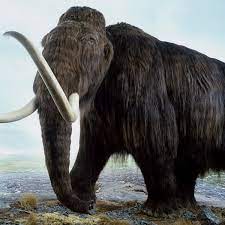Woolly Mammoth

The woolly mammoth, a colossal creature that once roamed the icy landscapes of the Pleistocene era, has long been extinct. However, recent advancements in genetic engineering and cloning technologies have sparked a controversial conversation about the possibility of resurrecting these ancient giants. This article delves into the history of the woolly mammoth, the scientific breakthroughs that could bring them back to life, and the ethical concerns surrounding such a resurrection.
The Woolly Mammoth’s Reign:
The woolly mammoth (Mammuthus primigenius) was a species of mammoth that lived during the Pleistocene epoch, approximately 400,000 years ago. With a distinctive coat of shaggy fur, long tusks, and adaptations to survive in harsh, cold climates, these creatures thrived in parts of Europe, Asia, and North America. They coexisted with early human populations and played a significant role in the ecosystems of their time.
Extinction and Preservation:
The woolly mammoth faced extinction due to a combination of climate change and human activities. As the Earth transitioned from the Pleistocene to the Holocene epoch, the mammoths struggled to adapt to the warming temperatures and changing vegetation. Additionally, hunting by early humans further contributed to their decline. The last known population of woolly mammoths disappeared from Wrangel Island in the Arctic Ocean around 4,000 years ago.
Despite their extinction, the frozen remains of woolly mammoths have been remarkably well-preserved in the permafrost of Siberia. Mammoth tusks, bones, and even entire carcasses have been discovered, providing scientists with valuable genetic material to explore the possibility of bringing these ancient creatures back to life.
Genetic Resurrection:
The ambitious idea of resurrecting the woolly mammoth gained traction with the advent of CRISPR-Cas9, a revolutionary gene-editing technology. Researchers have been able to extract intact DNA from well-preserved mammoth specimens found in Siberia. The next step involves using this DNA to edit the genes of a close relative of the mammoth – the Asian elephant (Elephas maximus).
The mammoth genes responsible for adaptations to cold climates, such as the thick fur and small ears, would be introduced into the elephant genome using CRISPR technology. The goal is to create a hybrid species known as a “mammophant” that possesses some of the key traits of its woolly ancestor. Scientists believe that introducing these mammoth traits could potentially help in the restoration of ecosystems and combat the effects of climate change.
Ecological Impact:
Proponents of woolly mammoth resurrection argue that reintroducing these creatures to their former habitats could have positive ecological effects. The mammoths were ecosystem engineers, meaning they shaped their environments through their feeding habits. They kept grasslands open by trampling on trees and shrubs, promoting the growth of herbaceous plants. This, in turn, could benefit other species in the ecosystem, such as smaller herbivores and birds.
Additionally, the compacted snow from mammoth trampling could enhance the reflection of sunlight, reducing the absorption of heat and mitigating the impacts of climate change. Some scientists believe that the presence of mammoths could contribute to a more resilient and balanced ecosystem.
Ethical Dilemmas:
While the scientific community continues to make strides in the potential resurrection of the woolly mammoth, ethical concerns have taken center stage. Critics argue that the focus should be on conserving existing endangered species rather than bringing back extinct ones. They question the morality of playing “de-extinction” given the uncertainties surrounding the consequences for ecosystems and the welfare of the resurrected creatures.
Furthermore, there are concerns about the well-being of the mammophants themselves. Being genetically engineered hybrids, these creatures may face challenges in adapting to their environments and interacting with other species. Questions arise about their mental and physical health, potential suffering, and the ethical responsibility of humans in creating and managing these resurrected beings.
Regulatory Frameworks and International Cooperation:
The prospect of resurrecting extinct species poses a unique challenge for global governance and regulation. The international community must grapple with establishing ethical guidelines, environmental impact assessments, and legal frameworks to govern the de-extinction process. Cooperation between scientists, ethicists, policymakers, and environmentalists is crucial to navigate the complex web of ethical, ecological, and legal considerations.
Conclusion:
The resurrection of the woolly mammoth is a captivating tale of scientific innovation, ecological restoration, and ethical dilemmas. As technology advances, humanity finds itself at a crossroads where the power to bring extinct species back to life comes with profound responsibilities. While the idea of a mammoth roaming the Arctic tundra once again captures the imagination, the ethical considerations surrounding de-extinction should not be underestimated. Striking a balance between scientific progress, ecological preservation, and ethical responsibility will be crucial as we navigate the uncharted territory of resurrecting ancient giants.






